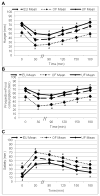Eating-related behaviors and appetite during energy imbalance in obese-prone and obese-resistant individuals
- PMID: 23402714
- PMCID: PMC3622833
- DOI: 10.1016/j.appet.2013.01.015
Eating-related behaviors and appetite during energy imbalance in obese-prone and obese-resistant individuals
Abstract
While the majority of Americans are now overweight, some individuals maintain their weight with minimal effort. This study investigated behavioral differences between 58 individuals recruited as either obese-resistant (OR) or obese-prone (OP) based on self-identification, BMI, and personal/family weight history. Subjects were studied during Eucaloric (EU), Overfed (OF), and Underfed (UF) phases which included a run-in diet, 1 day intervention diet, and a study day. At baseline, subjects completed the Three Factor Eating Questionnaire (TFEQ) and Power of Food Scale (PFS). On the study day, ratings of appetite, food appeal and desire, and food cravings were performed in response to a breakfast shake. OF resulted in reduced hunger and food desire while UF resulted in increased hunger and food appeal and desire. While hunger did not differ between groups, OP had higher scores for TFEQ measures (hunger, restraint and disinhibition), higher "hedonic hunger" as measured by the PFS, and greater food cravings and ratings of food appeal and desire. These results suggest that subjective hunger and desire for food change significantly after only one day of over- or underfeeding. Additionally, we found several behavioral differences between groups that are likely to promote weight gain over time in the OP.
Copyright © 2013 Elsevier Ltd. All rights reserved.
Figures

References
-
- Allison DB, Paultre F, Maggio C, Mezzitis N, Pi-Sunyer FX. The use of areas under curves in diabetes research. Diabetes Care. 1995;18:245–250. - PubMed
-
- Aurelie L, Gilles F, Jean-Jacques D, Agathe A, Sophie V, Daniel T, Agnes MB. Characterization of the Three-Factor Eating Questionnaire scores of a young French cohort. Appetite. 2012;59:385–390. - PubMed
-
- Bingham SA, Gill C, Welch A, Day K, Cassidy A, Khaw KT, Sneyd MJ, Key TJ, Roe L, Day NE. Comparison of dietary assessment methods in nutritional epidemiology: weighed records v. 24 h recalls, food-frequency questionnaires and estimated-diet records. Br J Nutr. 1994;72:619–643. - PubMed
Publication types
MeSH terms
Grants and funding
LinkOut - more resources
Full Text Sources
Other Literature Sources
Medical
Research Materials
Miscellaneous

